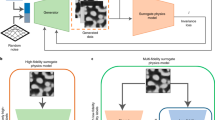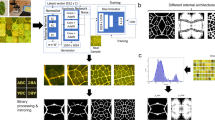Abstract
In this paper, we investigate the capability of generative adversarial networks, including conditional and conditional convolutional generative adversarial networks, in generating electromagnetic engineered surfaces (EES). Generative models such as generative adversarial networks and their conditional variants can be used to generate different categories of designs based on the current dataset. k-means clustering algorithm is used to obtain the desirable categories of EES designs, including an initial two main categories, followed by six and eight subcategories. Conditional and conditional convolutional generative adversarial networks are proposed and trained on designs with different image dimensions conditioned on different sets of categories. The trained conditional convolutional generative adversarial network models have comparable accuracy with conditional generative adversarial network in low-dimensional designs over two categories. Conditional convolutional generative adversarial networks generate more unique designs for six and eight categories for smaller image dimensions (e.g., 9 × 9 designs) and for two main categories over larger designs. Both generative adversarial network structures are suitable for generating a wide variety of low- and high-pass EES designs. The creation of new datasets can benefit from conditional convolutional generative adversarial networks to provide greater variety in designs.













Similar content being viewed by others
References
Bahmani B, Moseley B, Vattani A, Kumar R, Vassilvitskii S (2012) Scalable k-means++. Proc VLDB Endow 5(7):622–633
Caliński T, Harabasz J (1974) A dendrite method for cluster analysis. Commun Stat Theory Methods 3(1):1–27
dPKingma J (2015) Adam: a method for stochastic optimization. In: International conference on learning representations, pp 1–15
Ethier J, Chaharmir R, Shaker J, Hettak K (2018) Electromagnetic engineered surface gratings at 5g bands using printed electronics. In: International flexible electronics technology conference (IFETC)
Gauthier J (2014) Conditional generative adversarial nets for convolutional face generation. Class Project for Stanford CS231N: convolutional Neural Networks for Visual Recognition, Winter semester 2014(5):2
Goodfellow I, Pouget-Abadie J, Mirza M, Xu B, Warde-Farley D, Ozair S, Courville A, Bengio Y (2014) Generative adversarial nets. In: Advances in neural information processing systems, pp 2672–2680
Goodfellow I, Bengio Y, Courville A (2016) Deep Learning. MIT Press.http://www.deeplearningbook.org
Hjelm RD, Jacob AP, Che T, Trischler A, Cho K, Bengio Y (2017) Boundary-seeking generative adversarial networks. arXiv preprint arXiv:170208431
Hodge JA, Mishra KV, Zaghloul AI (2019a) Joint multi-layer gan-based design of tensorial rf metasurfaces. In: 2019 IEEE 29th International Workshop on Machine Learning for Signal Processing (MLSP), IEEE, pp 1–6
Hodge JA, Mishra KV, Zaghloul AI (2019b) Multidiscriminator distributed generative model for multi-layer rf metasurface discovery. In: IEEE global conference on signal and information processing
Hodge JA, Mishra KV, Zaghloul AI (2019c) Rf metasurface array design using deep convolutional generative adversarial networks. In: IEEE international symposium on phased array systems and technology
Huang GB, Mattar M, Berg T, Learned-Miller E (2008) Labeled faces in the wild: a database for studying face recognition in unconstrained environments
Mirza M, Osindero S (2014) Conditional generative adversarial nets. arXiv preprint arXiv:14111784
Munk B (2000) Frequency selective surfaces: theory and design, vol 1. Wiley, London
Nigam A, Friederich P, Krenn M, Aspuru-Guzik A (2020) Augmenting genetic algorithms with deep neural networks for exploring the chemical space. In: International conference on learning representations (ICLR)
Ohira M, Deguchi H, M T, Shigesawa H (2004) Multiband single-layer frequency selective surface designed by combination of genetic algorithm and geometry-refinement technique. In: IEEE transactions on antennas and propagation, p 52
Ozyegen O, Kavurmacioglu E, Ethier J, Başar A (2019) Generative adversarial networks in designing electromagnetic engineered surfaces for mm-wave band spectrum environments. In: Proceedings of the 29th annual international conference on computer science and software engineering, IBM Corp., pp 148–155
Pedregosa F, Varoquaux G, Gramfort A, Michel V, Thirion B, Grisel O, Blondel M, Prettenhofer P, Weiss R, Dubourg V, Vanderplas J, Passos A, Cournapeau D, Brucher M, Perrot M, Duchesnay E (2011) Scikit-learn: machine learning in Python. J Mach Learn Res 12:2825–2830
Petosa A, Gagnon N, Amaya C, Li M, Raut S, Ethier J, Chaharmir R (2018) Characterization and enhancement of the environment for 5g millimetre-wave broadband mobile communications. In: IET, 12th European conference on antennas and propagation (EuCAP)
Radford A, Metz L, Chintala S (2015) Unsupervised representation learning with deep convolutional generative adversarial networks. arXiv preprint arXiv:151106434
Rappaport TS, Sun S, Mayzus R, Zhao H, Azar Y, Wang K, Wong GN, Schulz JK, Samimi M, Gutierrez F (2013) Millimeter wave mobile communications for 5G cellular: It will work!. IEEE Access 1:335–349
Rosenberg A, Hirschberg J (2007) V-measure: a conditional entropy-based external cluster evaluation measure. In: Proceedings of the 2007 joint conference on empirical methods in natural language processing and computational natural language learning (EMNLP-CoNLL), pp 410–420
Rousseeuw PJ (1987) Silhouettes: a graphical aid to the interpretation and validation of cluster analysis. J Comput Appl Math 20:53–65
Salakhutdinov R, Hinton G (2009) Deep boltzmann machines. In: Artificial intelligence and statistics, pp 448–455
Salimans T, Goodfellow I, Zaremba W, Cheung V, Radford A, Chen X (2016) Improved techniques for training gans. In: Advances in neural information processing systems, pp 2234–2242
Shaker J, Chaharmir R, Ethier J (2013) Reflectarray antennas: analysis, design, fabrication, and measurement, vol 1. Artech House
Srivastava N, Hinton G, Krizhevsky A, Sutskever I, Salakhutdinov R (2014) Dropout: a simple way to prevent neural networks from overfitting. J Mach Learn Res 15:1929–1958
XPU IE (2019) Empire xpu, v 7.6. https://imst.de/
Acknowledgements
This research is enabled by the dataset supplied by Communications Research Centre Canada.
Author information
Authors and Affiliations
Corresponding author
Ethics declarations
Conflict of interest
The authors declare that there is no conflict of interest regarding publishing this paper.
Additional information
Publisher's Note
Springer Nature remains neutral with regard to jurisdictional claims in published maps and institutional affiliations.
Rights and permissions
About this article
Cite this article
Mohammadjafari, S., Ozyegen, O., Cevik, M. et al. Designing mm-wave electromagnetic engineered surfaces using generative adversarial networks. Neural Comput & Applic 33, 11309–11323 (2021). https://doi.org/10.1007/s00521-020-05656-2
Received:
Accepted:
Published:
Issue Date:
DOI: https://doi.org/10.1007/s00521-020-05656-2




